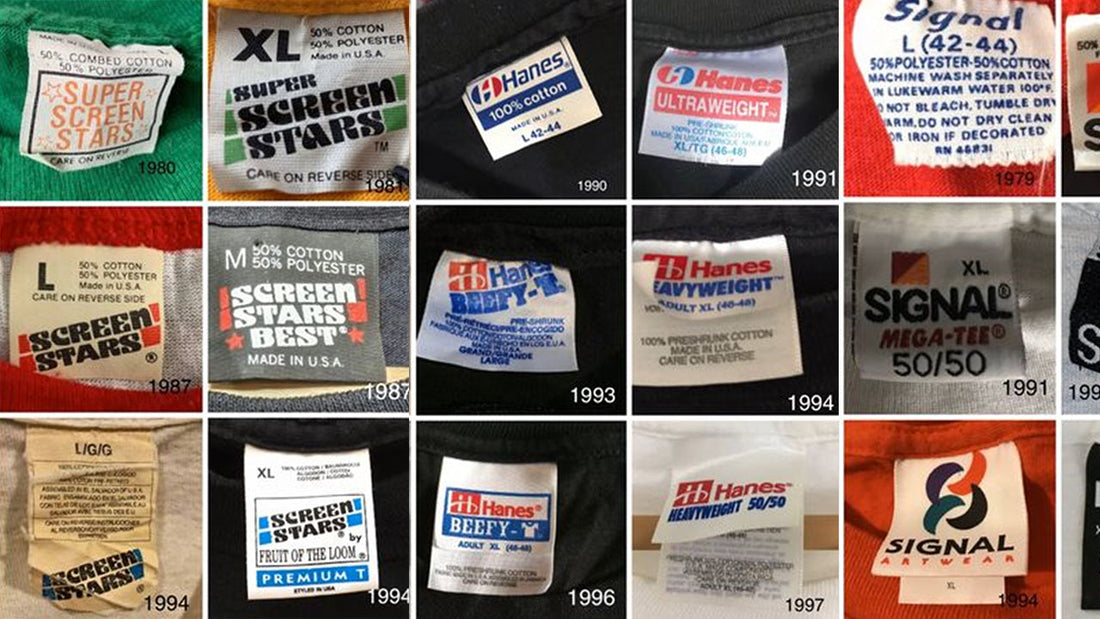
The Story Behind the Tag: Identifying Eras by Tags
Share
The Story Behind the Tag: Identifying Eras by Tags
“Tag Talk: How to Read the Age and Authenticity of a Vintage Tee”
If you're serious about vintage T-shirts—whether collecting, selling, or just appreciating the history—there’s one detail that speaks volumes before you even look at the graphic: the tag.
Neck tags are the DNA of vintage. They tell you where and when the shirt was made, who made it, and whether it’s authentic vintage or a modern reprint. Think of it like reading tree rings—if you know what to look for, you can trace the age and story of the shirt.
Here’s your guide to decoding vintage T-shirt tags and using them to verify age, era, and value.
📅 1. Understand the Timeline of Tag Styles
1970s–Early 80s: Paper Tags & Made in USA
-
Look for: Thin paper-like tags, often with basic fonts and few design elements.
-
Common brands: Hanes 50/50, Sportswear, Healthknit
-
Tells: Early screen printing era, often single-stitch construction, usually made in the USA.
These are among the earliest "true" vintage tags—fragile and often faded or torn off. If you find a full one intact, that's a plus.
🧵 2. Mid-80s to Early 90s: Soft Cotton & Iconic Logos
Golden era of vintage tees
-
Look for: Bold brand logos, colorful designs (like the rainbow Screen Stars), and soft 50/50 blends
-
Common brands:
-
Screen Stars / Screen Stars Best
-
Hanes Beefy-T
-
Jerzees
-
Stedman
-
Brockum (for band tees)
-
-
Tells: Tour shirts, movie merch, and pop culture tees from this era are collector gold. These tags scream vintage authenticity.
Pro tip: The “Made in USA” detail combined with single stitch is a strong sign of a late-80s to early-90s tee.
🔄 3. Late 90s to Early 2000s: Transition Era
As manufacturing began to shift overseas, so did the tags.
-
Look for: Printed tags begin to appear, more use of “Made in Honduras,” “Mexico,” etc.
-
Common brands: Delta, Gildan, Fruit of the Loom Heavy
-
Tells: Still considered vintage (especially Y2K), but often less valuable unless tied to niche culture (e.g., early 2000s rap, emo bands, etc.)
👕 4. Tagless Tees & Modern Reprints (Mid-2000s–Present)
This is where it gets tricky. Many new shirts are designed to look vintage—but the tag gives them away.
-
Look for: Printed tags directly on the neck, no stitched tag at all
-
Common brands: Modern Gildan, AAA, Tultex, or merch company names like Bravado or Ripple Junction
-
Tells: Often reprints or retro-style pieces. Not true vintage, though some are collectible for design (e.g., Travis Scott tour tees).
Red flag: If a Nirvana shirt has a printed Gildan tag and says “2019” in the copyright—it's not vintage, no matter how distressed it looks.
🔍 5. Bootlegs, Blanks, and Oddities
Bootleg vintage shirts—especially from hip-hop and street culture—often come with no tag, a cut tag, or unusual blank brands.
-
No tag at all: Common with early bootleg rap tees
-
Blank brands: Look for brands like FOTL or Hanes with no graphic branding
-
Tells: Rarity and cultural relevance matter more than the tag here. If it's a Tupac bootleg from the ‘90s on a nondescript blank, it could still be worth a lot.
Sometimes, the absence of a tag is part of the shirt’s mystique.
🔎 Bonus: How to Use the RN Number
Every shirt tag has an RN (Registered Identification Number), and you can look this up to see which company it was registered to. It won’t tell you the exact year, but it can confirm authenticity.
-
Visit rn.ftc.gov to look it up
-
Example: RN 15763 = Fruit of the Loom
Final Thoughts
The tag on a vintage tee is more than just a label—it's a time capsule. It helps authenticate the shirt, determine its era, and gauge its value. Whether you're digging through a thrift bin or buying off IG, always check the tag. It might be the difference between a $20 tee and a $200 grail.
Tag tip of the day:
If you’re not sure about a tag, post a photo and ask the community. The vintage world runs on shared knowledge—and the right tag can make or break a deal.
